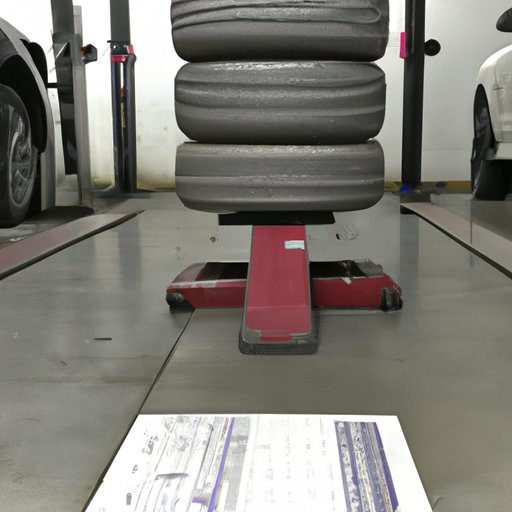Introduction
Tire balancing is a crucial component of vehicle maintenance. When done correctly, it can help improve ride quality, prolong tire life, and reduce the risk of premature tire wear. But what exactly is tire balancing, and why is it so important? This article will explore the basics of tire balancing, demonstrate proper balancing techniques, discuss the benefits of balanced tires, and answer some common questions about tire balancing.
Tire Balancing Basics
Tire balancing is the process of adjusting the weight distribution on a wheel and tire assembly to ensure that all parts are evenly balanced. This helps reduce vibration and uneven tire wear, which can cause premature tire failure. To balance a tire, you’ll need a few tools, including a tire balancer, weights, and a tire pressure gauge.
The tire balancer is the main tool used for tire balancing. It’s a device that measures the weight of each wheel and tire assembly and then determines where additional weight should be added or removed to achieve the correct balance. Weights are then added or removed from the wheel and tire assembly to achieve the desired balance.
Once the weights have been added or removed, the tire balancer is used again to measure the balance of the wheel and tire assembly. If the balance is not within an acceptable range, additional weights may need to be added or removed until the desired balance is achieved.
Demonstrating Proper Balancing Techniques
To properly balance a tire, follow these steps:
- Inflate the tire to the recommended pressure.
- Mount the tire onto the wheel and attach the wheel to the tire balancer.
- Use the tire balancer to measure the balance of the wheel and tire assembly.
- If necessary, add or remove weights from the wheel and tire assembly to achieve the desired balance.
- Re-measure the balance of the wheel and tire assembly to ensure that it is within an acceptable range.
- Remove the wheel and tire assembly from the tire balancer, then reinflate the tire to the recommended pressure.
When adding or removing weights from the wheel and tire assembly, it’s important to make sure that the weights are securely attached. Additionally, it’s important to use the correct type of weights; some vehicles require specific types of weights, such as clip-on or adhesive weights.
Benefits of Balanced Tires
Properly balanced tires can provide several benefits, including improved ride quality, longer tire life, and reduced risk of premature tire wear. With balanced tires, you’ll experience a smoother, more comfortable ride, and your tires will last longer because they won’t be subject to excessive wear and tear.
Additionally, balanced tires can help improve fuel economy and reduce road noise. By reducing the amount of friction between the tire and the road, balanced tires can help your vehicle run more efficiently, and the reduced road noise can make for a more pleasant driving experience.
Common Questions About Tire Balancing
Here are some common questions about tire balancing:
- How often should I balance my tires? Generally, it’s recommended that you balance your tires every 10,000 miles or whenever you replace your tires.
- What are the signs of an unbalanced tire? Unbalanced tires can cause vibrations when driving, uneven tire wear, and decreased fuel efficiency.
Conclusion
Tire balancing is an important part of vehicle maintenance that can help improve ride quality, prolong tire life, and reduce the risk of premature tire wear. By following the steps outlined in this article and using the proper tools and techniques, you can ensure that your tires are properly balanced and ready to provide safe, reliable performance.
Balancing your tires every 10,000 miles or whenever you replace them is the best way to ensure that your tires are performing optimally. If you notice any signs of an unbalanced tire, such as vibration or uneven tire wear, it’s important to get your tires balanced as soon as possible.
By understanding the basics of tire balancing and following the proper procedures, you can ensure that your tires are providing the best possible performance and longevity.


